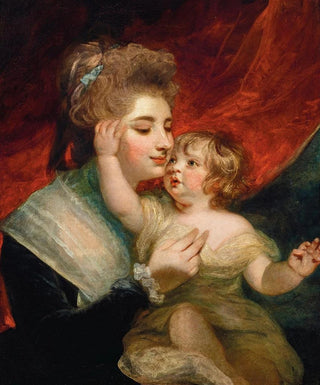Art print | Portrait of Lady Dashwood 1763-1796 and her son Henry George Mayne - Sir Joshua Reynolds


View from behind

Frame (optional)
Reproduction Portrait of Lady Dashwood 1763-1796 and her son Henry George Mayne - Sir Joshua Reynolds – Captivating introduction
The "Portrait of Lady Dashwood 1763-1796 and her son Henry George Mayne" by Sir Joshua Reynolds is an iconic work that transcends the simple frame of a pictorial representation. By capturing the essence of aristocratic life in the 18th century, this painting invites viewers to immerse themselves in a world of refinement and elegance. The relationship between mother and son, as well as the meticulous details of their costumes, testify to an era when portraiture served not only to immortalize individuals but also to affirm their social status. Through this work, Reynolds does not merely paint figures; he creates an atmosphere charged with emotion and meaning, making the painting timeless and universal.
Style and uniqueness of the work
Reynolds' style is distinguished by its ability to combine realism and idealization. In this portrait, the delicacy of Lady Dashwood and her son's features is highlighted by a soft, enveloping light that gives the scene an almost spiritual dimension. The drapery of their clothing, carefully rendered, demonstrates exceptional technical mastery, while the chosen poses suggest palpable intimacy and tenderness between the two figures. The subtly blurred background allows focus to remain on the faces, thus emphasizing the psychological depth of the characters. Reynolds succeeds in capturing not only their external appearance but also their soul, which grants the work a rare emotional strength.
The artist and his influence
Sir Joshua Reynolds, an emblematic figure of British portraiture, played a leading role in the evolution of art in the 18th century. As the first president of the Royal Academy, he not only influenced his contemporaries but also left a lasting legacy for future generations. His ability to blend classical elements with touches of modernity paved the way for new artistic approaches. Reynolds skillfully used light and color to create dynamic compositions, while preserving the dignity and status of his subjects. The "Portrait of Lady Dashwood" perfectly illustrates this dual

Matte finish

View from behind

Frame (optional)
Reproduction Portrait of Lady Dashwood 1763-1796 and her son Henry George Mayne - Sir Joshua Reynolds – Captivating introduction
The "Portrait of Lady Dashwood 1763-1796 and her son Henry George Mayne" by Sir Joshua Reynolds is an iconic work that transcends the simple frame of a pictorial representation. By capturing the essence of aristocratic life in the 18th century, this painting invites viewers to immerse themselves in a world of refinement and elegance. The relationship between mother and son, as well as the meticulous details of their costumes, testify to an era when portraiture served not only to immortalize individuals but also to affirm their social status. Through this work, Reynolds does not merely paint figures; he creates an atmosphere charged with emotion and meaning, making the painting timeless and universal.
Style and uniqueness of the work
Reynolds' style is distinguished by its ability to combine realism and idealization. In this portrait, the delicacy of Lady Dashwood and her son's features is highlighted by a soft, enveloping light that gives the scene an almost spiritual dimension. The drapery of their clothing, carefully rendered, demonstrates exceptional technical mastery, while the chosen poses suggest palpable intimacy and tenderness between the two figures. The subtly blurred background allows focus to remain on the faces, thus emphasizing the psychological depth of the characters. Reynolds succeeds in capturing not only their external appearance but also their soul, which grants the work a rare emotional strength.
The artist and his influence
Sir Joshua Reynolds, an emblematic figure of British portraiture, played a leading role in the evolution of art in the 18th century. As the first president of the Royal Academy, he not only influenced his contemporaries but also left a lasting legacy for future generations. His ability to blend classical elements with touches of modernity paved the way for new artistic approaches. Reynolds skillfully used light and color to create dynamic compositions, while preserving the dignity and status of his subjects. The "Portrait of Lady Dashwood" perfectly illustrates this dual






